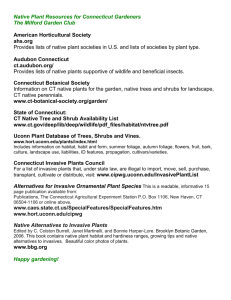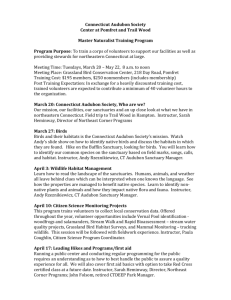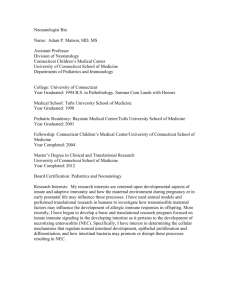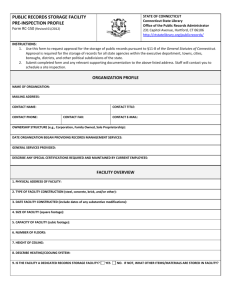land__water_conservation - Audubon Vermont
advertisement
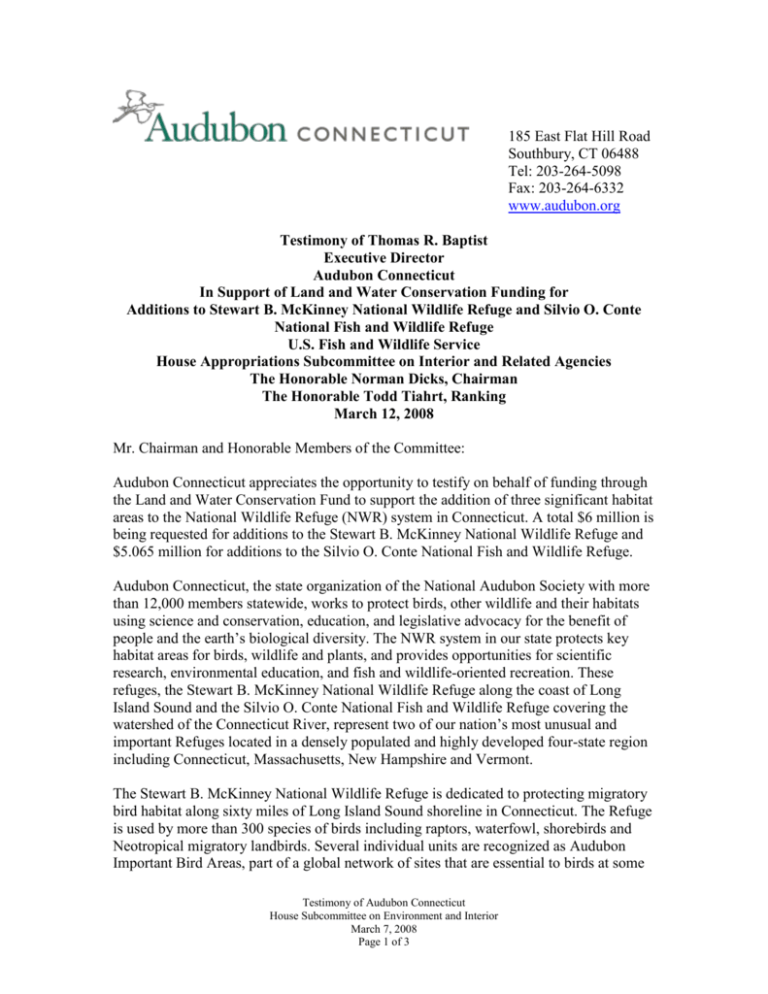
185 East Flat Hill Road Southbury, CT 06488 Tel: 203-264-5098 Fax: 203-264-6332 www.audubon.org Testimony of Thomas R. Baptist Executive Director Audubon Connecticut In Support of Land and Water Conservation Funding for Additions to Stewart B. McKinney National Wildlife Refuge and Silvio O. Conte National Fish and Wildlife Refuge U.S. Fish and Wildlife Service House Appropriations Subcommittee on Interior and Related Agencies The Honorable Norman Dicks, Chairman The Honorable Todd Tiahrt, Ranking March 12, 2008 Mr. Chairman and Honorable Members of the Committee: Audubon Connecticut appreciates the opportunity to testify on behalf of funding through the Land and Water Conservation Fund to support the addition of three significant habitat areas to the National Wildlife Refuge (NWR) system in Connecticut. A total $6 million is being requested for additions to the Stewart B. McKinney National Wildlife Refuge and $5.065 million for additions to the Silvio O. Conte National Fish and Wildlife Refuge. Audubon Connecticut, the state organization of the National Audubon Society with more than 12,000 members statewide, works to protect birds, other wildlife and their habitats using science and conservation, education, and legislative advocacy for the benefit of people and the earth’s biological diversity. The NWR system in our state protects key habitat areas for birds, wildlife and plants, and provides opportunities for scientific research, environmental education, and fish and wildlife-oriented recreation. These refuges, the Stewart B. McKinney National Wildlife Refuge along the coast of Long Island Sound and the Silvio O. Conte National Fish and Wildlife Refuge covering the watershed of the Connecticut River, represent two of our nation’s most unusual and important Refuges located in a densely populated and highly developed four-state region including Connecticut, Massachusetts, New Hampshire and Vermont. The Stewart B. McKinney National Wildlife Refuge is dedicated to protecting migratory bird habitat along sixty miles of Long Island Sound shoreline in Connecticut. The Refuge is used by more than 300 species of birds including raptors, waterfowl, shorebirds and Neotropical migratory landbirds. Several individual units are recognized as Audubon Important Bird Areas, part of a global network of sites that are essential to birds at some Testimony of Audubon Connecticut House Subcommittee on Environment and Interior March 7, 2008 Page 1 of 3 point in their life cycle. The Stewart B. McKinney NWR provides critical habitat for federally endangered Roseate Terns, federally threatened Piping Plovers, and a globally significant nesting population of Salt Marsh Sharp-tailed Sparrows, listed by the State of Connecticut as a Species of Special Concern and as Globally ‘Vulnerable’ by BirdLife International. The Silvio O. Conte National Fish and Wildlife Refuge - the nation’s only Fish and Wildlife Refuge - consists of approximately 180,000 acres in 48 identified “special focus areas” within the 7.2 million acre watershed of the Connecticut River in Connecticut, Massachusetts, New Hampshire and Vermont. These areas contribute substantially and in unique ways to supporting natural diversity in the watershed and provide habitat for numerous species of birds including our nation’s symbol, the Bald Eagle. Two individual units in Connecticut are recognized as Audubon Important Bird Areas. The areas currently proposed for acquisition would constitute only the second acquisition of property in the State of Connecticut by the Conte Refuge. Audubon Connecticut strongly supports the following 2008 Land and Water Conservation Fund requests: $6 million for phase I of a multi-year effort to acquire the Long Beach/Pleasure Beach project in Stratford and Bridgeport, Connecticut that would conserve a 70acre barrier beach adjacent to the state’s largest city, a distressed and targeted community. This will be first of several phases for this project. The beach shelters the 700-acre estuarine system of the Stratford-Great Meadows Unit of the Stewart B. McKinney National Wildlife Refuge, and represents the most important remaining block of nesting habitat for the federally threatened Piping Plover and state threatened Least Tern in Connecticut. Long Beach and Pleasure Beach represent 20% of Connecticut’s remaining undeveloped coastline. More than 270 bird species utilize this area, and the addition of the Long Beach/Pleasure Beach property to the Refuge would create one of the premier birding areas in all of New England. Acquisition of this area by the USFWS will simultaneously improve public access, improve resource management for federally listed species and provide a new amenity to Connecticut’s largest city, Bridgeport. With both municipalities willing to sell their sites to USFWS, this is a unique opportunity to conserve critical bird habitat while also providing high quality wildlife-oriented recreation opportunities in an urban environment. $2 million for acquisition of the Elm Camp/Johnson property, three (3) parcels that would add a total of 389 acres along the pristine Salmon River, a tributary to the Connecticut River, to the Salmon River Division of the Silvio O. Conte National Fish and Wildlife Refuge, as well as $3.065 million (a total request of $5.065 million) for additional properties in Massachusetts, New Hampshire and Vermont as part of a four-state coalition effort to permanently protect key areas in this unique Refuge that runs through the four-state region and spans the watershed of New England's longest river. The Salmon River Division in Connecticut Testimony of Audubon Connecticut House Subcommittee on Environment and Interior March 7, 2008 Page 2 of 3 represents critical wintering habitat for Bald Eagles and nesting habitat for American Black Ducks, Wood Ducks, and Mallards, along with critical wetland, forest and shrubland habitat for many other species of conservation concern. The Elm Camp/Johnson property would represent only the second unit of the Refuge in Connecticut and the first addition to the Salmon River Division. The property contains 3,360 feet of frontage on Pine Brook, a high-quality stream that provides outstanding cold-water fish habitat, as well as 1,440 feet on the west bank of the Salmon River where there have been extensive state and federal efforts to restore anadromous fish runs, including the Atlantic salmon. Pine Brook is the only major Salmon tributary free of artificial barriers to migratory fish. The acquisition of these parcels by the US Fish and Wildlife Service will continue efforts to protect bird habitat along the highly developed coastline of Long Island Sound and watershed of the Connecticut River. If funding is not made available in FY 09, there is a strong possibility that these parcels could be developed and Connecticut would lose more of the already-rare salt marsh and riverine habitats found on the subject properties. On behalf of Audubon Connecticut, I respectfully request your support in the FY 09 Interior Appropriations bill to ensure the success of these important conservation projects that will benefit the people of our state and our nation for generations to come. Thank you for your consideration of these requests. Audubon Connecticut, the state organization of the National Audubon Society with more than 12,000 members statewide, works to protect birds, other wildlife and their habitats using science and conservation, education, and legislative advocacy for the benefit of people and the earth’s biological diversity. Through our network of nature centers, protected wildlife sanctuaries, and local volunteer Chapters, we seek to connect people with nature and inspire the next generation of conservationists. Testimony of Audubon Connecticut House Subcommittee on Environment and Interior March 7, 2008 Page 3 of 3


